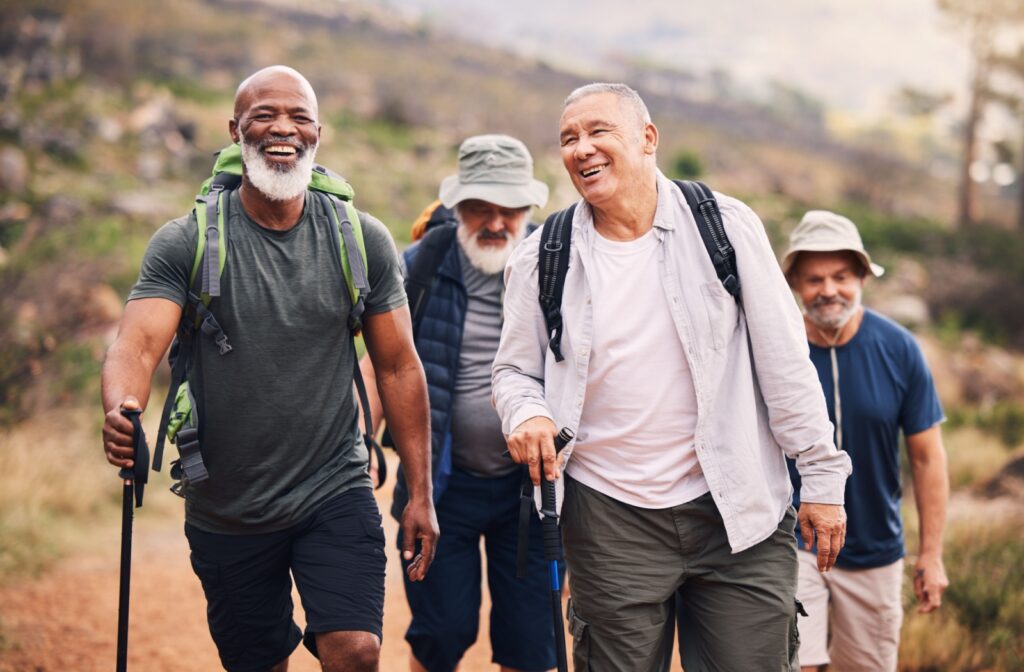Exercise is a key factor for a healthy life, especially as we age. For older adults, staying active isn’t just about maintaining physical fitness; it’s a means of carrying out activities of daily living, enhancing overall well-being, boosting mental health, and improving quality of life.
Older adults, 65 and over, need at least 150 minutes a week of moderate exercise or 75 minutes of intense exercise, 2 days of strength exercises, and activities that improve balance. Older adults in senior communities benefit from the support provided to reach personalized fitness goals.
The Effects of Aging on the Body
Aging naturally brings about changes in your health and body. Muscles may lose strength, flexibility might decrease, and bones can become more fragile. Common health concerns for older adults include arthritis, heart disease, and osteoporosis, alongside a heightened risk for falls and injuries. However, the good news is that regular physical activity can significantly counter these risks.
The Benefits of Regular Physical Activity
Physical activity in the form of exercise is planned, structured, and repetitive activities that help to improve or maintain physical function. Physical function is important for everyone, particularly older adults, as it determines their ability to perform activities of daily living.
Regular exercise can improve mental health, emotional, psychological, social well-being, and cognitive function, leading to a more independent lifestyle in older adults. Regular physical activity helps control weight, strengthens muscles and bones, reduces pain, and improves heart health. Additionally, it can have a profound impact on mental health, with reduced rates of depression and anxiety.
How Much Exercise Do Seniors Need?
While each individual’s capacity for exercise will vary, here’s a general guideline according to the Centers for Disease Control and Prevention. Those 65 years and older, if possible, should commit to the following exercise frequency:
- At least 150 minutes a week of moderate-intensity activity.
- 75 minutes a week of vigorous-intensity activity.
- Muscle-strengthening activities on 2 or more days a week.
- Exercises to improve balance.
Recommended Types of Exercises for Seniors
A well-rounded exercise program for older adults should include a mix of cardiovascular exercises (like walking or swimming), strength training (using light weights or resistance bands), flexibility exercises (such as yoga or stretching), and balance exercises.
Moderate-Intensity Activities
Moderate-intensity activities make you breathe harder, and your heart beat faster. While you can talk when doing moderate-intensity activities, you won’t be able to sing.
Older adults can break down the 150 minutes a week into manageable 30-minute sessions across 5 days to make the goal more achievable. Moderate-intensity activities can include brisk walking, dancing, yoga, and swimming.
Vigorous-Intensity Activities
With vigorous-intensity activity, your heart rate increases even more, you breathe harder, and you shouldn’t be able to say more than a few words. Vigorous activity for 1 hour and 15 minutes can include jogging, running, or hiking.
Muscle-Strengthening Activities
For the 2 days a week of exercises that strengthen muscles, perform exercises that work all the major muscles such as the legs, hips, back, abdomen, chest, shoulders, and arms.
Balance Activities
Balance exercises can help prevent falls and injuries. Examples of balance activities include walking backward, standing on one leg, yoga, and Tai chi.
Making Exercise More Accessible
Several obstacles can stand in the way of older adults looking to lead an active lifestyle. Physical limitations, fears of injury, and a lack of motivation are among the most common. Accessibility to safe and suitable places to exercise can further complicate matters.
To overcome these hurdles, older adults can start by setting realistic goals and incorporating activities they enjoy into their routine. Establishing a social support network, such as in senior communities, helps as older adults can exercise with friends or in group classes.
Tailoring Exercise Programs for Seniors
Before beginning any new exercise regime, older adults should consult with healthcare professionals to make sure the plan meets their individual needs and addresses any health conditions. Personalization makes all the difference since what works for one person may not be suitable for another. If older adults can’t meet these exercise recommendations, they can try to be as active as possible, as some exercise is better than none.
Supporting Your Health
Life doesn’t have to slow down as you age. Staying active through senior years is about more than just longevity; it’s about adding life to those years. Older adults in senior communities can benefit from amenities and resources like group walks or fitness classes tailored to their needs, abilities, and health. Book a tour with The Legacy at South Plains to learn more about our programs and personalized approach to helping older adults maintain their health and wellness.


